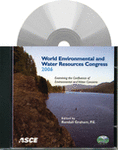Linking Benthic Macroinvertebrate Bioassessments to Channel Stability and Bed Sediment Characteristics
Publication: World Environmental and Water Resource Congress 2006: Examining the Confluence of Environmental and Water Concerns
Abstract
As watersheds are disturbed by human activities on the land and in the streams, hydrology and sediment budgets are modified so that channel morphological instabilities occur, promoting further changes in watershed sediment dynamics. Because channel morphology and physical habitat structure are interrelated, it can be assumed that unstable channel conditions cause unstable habitat conditions, thereby lowering biological integrity. Better watershed assessment tools are needed that link channel stability to physical habitat structure and biological integrity. This study's approach evaluates the utility of channel stability index, the Rapid Geomorphic Assessment (RGA) assessment protocol developed by the USDA National Sedimentation Laboratory to predict sediment impairment as indicated by bethnic macroinvertebrate indices of biological integrity (MIBI). In addition, this study evaluated different sediment size classes and their correlation to MIBI scores. In our study, 76 sites in Ecoregion 67, the Ridge and Valley EcoRegion of East Tennessee were examined for channel stability and bed sediment particle size distributions (PSDs) at stream sites with MIBI scores conducted by the Tennessee Department of Environment and Conservation. Bed sediment was collected in a unique field protocol to capture sediment transport "history", and PSDs were conducted by standard ASTM methods. The analysis found a strong positive relationship between RPBIII scores and larger bed sediment material (gravel to cobble), and a negative relationships with fine sediment at approximately 0.016 mm (silt). Finer sediments < 0.016 mm such as clay did relate as well as the above stated relationships. This information is important for the development of sediment TMDLs, indicating that instream BMPs that create riffle habitat will be effective over some of the negative ecological stress imposed by fine sediments, primarily in the silt size range. Other than visually aesthetics, the clay fraction may not be as important ecologically as having gravel or larger bed sediments to create good habitat structure.
Get full access to this chapter
View all available purchase options and get full access to this chapter.
Information & Authors
Information
Published In
Copyright
© 2006 American Society of Civil Engineers.
History
Published online: Apr 26, 2012
ASCE Technical Topics:
- Bed materials
- Biological processes
- Channel stabilization
- Channels (waterway)
- Ecological restoration
- Ecosystems
- Environmental engineering
- Hydraulic engineering
- Hydraulic structures
- River and stream beds
- River engineering
- River systems
- Rivers and streams
- Sediment
- Stream channels
- Waste management
- Water and water resources
- Watersheds
- Waterways
Authors
Metrics & Citations
Metrics
Citations
Download citation
If you have the appropriate software installed, you can download article citation data to the citation manager of your choice. Simply select your manager software from the list below and click Download.
